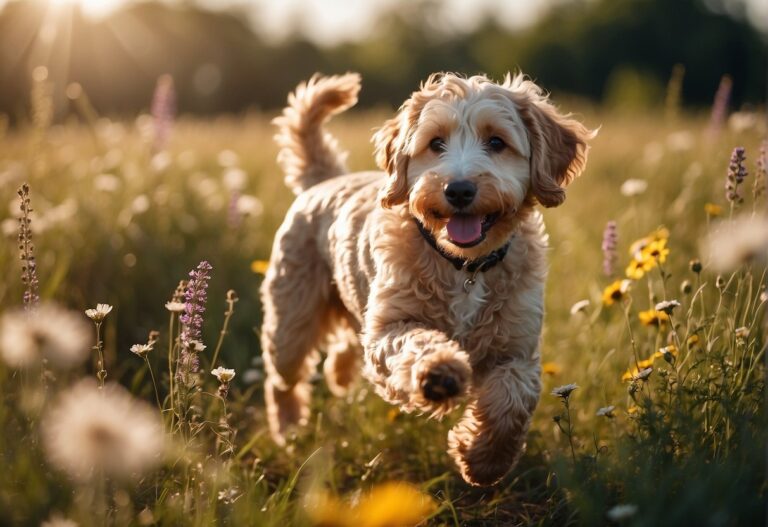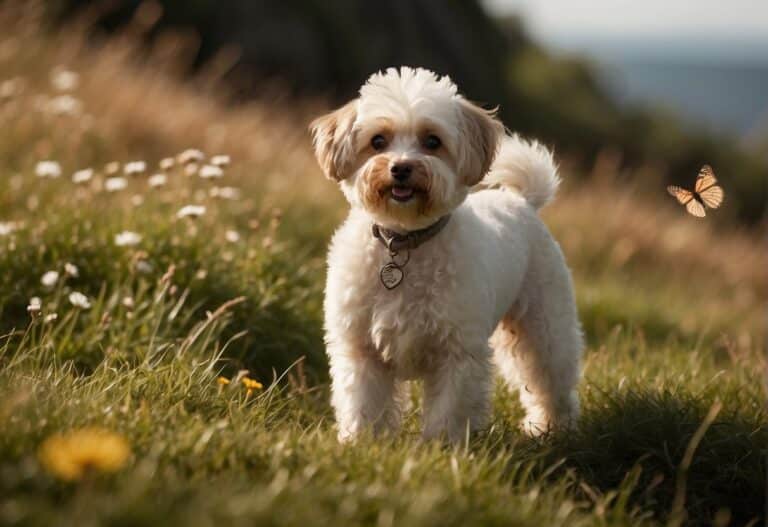F3 Goldendoodles – Third Filial Generation of Cute Doodles

F3 Goldendoodles represents the newest generation in a line of hybrid dogs known for their intelligence and hypoallergenic qualities. As a third-generation Goldendoodle, an F3 puppy is the result of breeding two F2 Goldendoodles together. This combines the sought-after traits of their predecessors, such as a friendly disposition and a low-shedding coat, with a level of consistency in temperament and appearance that appeals to many dog lovers.
These multigenerational canines are cherished for their compatibility with families, potential for reduced shedding, and a balance of both Golden Retriever and Poodle characteristics. Opting for an F3 Goldendoodle might be ideal if you’re seeking a furry companion that embodies the best traits of its lineage while also accommodating better to allergy sufferers.
- An F3 Goldendoodle is the result of breeding two F2 Goldendoodles.
- They are known for their consistent traits, hypoallergenic qualities, and friendly nature.
- F3 Goldendoodles can be a good match for families, including those with allergy concerns.
Breed Overview of F3 Goldendoodles

In the world of designer dogs, the complexity of Goldendoodle generations can sometimes be confusing. Your comprehension of F3 Goldendoodles, a third-generation blend, hinges on knowledge of their genetic composition and how it affects their characteristics.
Goldendoodle Generations Explained
F1 to F3 – A Brief Overview:
- F1 Goldendoodle: 50% Golden Retriever, 50% Poodle – the first generation hybrid.
- F1B Goldendoodle: 75% Poodle, 25% Golden Retriever – an F1 Goldendoodle backcrossed with a Poodle.
- F1BB Goldendoodle: 87.5% Poodle, 12.5% Golden Retriever – an F1B backcrossed with a Poodle.
- F2 Goldendoodle: Second-generation, bred from two F1 Goldendoodles.
- F2B Goldendoodle: 62.5% Poodle, 37.5% Golden Retriever – an F2 backcrossed with a Poodle.
- F2BB Goldendoodle: Higher percentage of Poodle – an F2B backcrossed with a Poodle.
- F3 or Multi-generation Goldendoodle: Typically, two F2Bs bred together, although the term can refer to any third-generation Goldendoodle or beyond.
“Backcross” refers to breeding a hybrid dog (like an F1 Goldendoodle) with one of its original purebred ancestors (such as a Poodle). Each subsequent generation can exhibit varying degrees of what’s known as hybrid vigor, which refers to the health and vigor of hybrid offspring. A filial hybrid is the scientific term for these crossbred pups.
F3 Goldendoodle Characteristics
Genetic Traits:
An F3 Goldendoodle is indeed a third-generation cross, often encompassing a blend of the following lineage:
- 50% Golden Retriever
- 50% Poodle
By reaching this stage in breeding, F3 Goldendoodles may exhibit a combination of both predictability in terms of traits and the benefits of hybrid vigor. These can include:
- More consistent coat types: Wavy or curly coats that may be friendlier for allergy sufferers.
- Potentially less shedding: Aimed at maintaining the Poodle’s characteristic of a low-shedding coat.
Character & Temperament:
Your F3 Goldendoodle is likely to inherit established personality traits from its multi-generation lineage:
- Friendly and sociable nature
- Intelligence and trainability from both the Poodle and Golden Retriever ancestors
Breeders may aim to enhance particular characteristics through careful selection in the breeding process. With each backcross and new filial hybrid generation, breeders seek to stabilize certain desired attributes, such as coat type, general health, or demeanor.
Health and Grooming
Understanding the health and grooming needs of your F3 Goldendoodle is crucial to its well-being. Proper grooming helps prevent matting and reduces dander, while attention to health can prevent common genetic issues.

Managing Coat Types
Your F3 Goldendoodle may have a curly, wavy, or straight coat, each carrying distinct grooming needs. Curly coats often require more frequent brushing to prevent tangles and mats, while wavy and straight types may be easier to manage but still need regular grooming.
All coat types benefit from a consistent grooming schedule that typically involves brushing several times a week. For non-shedding and low shedding Goldendoodles, this maintenance is essential not only for appearance but also to reduce allergens like dander which can affect people with allergies.
Promoting Good Health
F3 Goldendoodles are generally healthy, but like any breed, they may be prone to certain genetic health issues. Being vigilant and proactive about your dog’s health is important. Common conditions to be aware of include hip dysplasia, elbow dysplasia, and patellar luxation.
Regular check-ups with your veterinarian will help monitor and manage these potential health concerns. Maintaining a hypoallergenic environment can also be beneficial if allergy sufferers are in your household. To promote overall health, ensure your Goldendoodle gets adequate exercise, a balanced diet, and mental stimulation.
Choosing the Right Goldendoodle

When selecting an F3 Goldendoodle, it’s crucial to consider their temperament and the size variations that come with this breed to ensure they fit well with your lifestyle and living space.
Temperament and Personality
F3 Goldendoodles tend to inherit a friendly and playful nature that makes them excellent family pets. They are typically highly social dogs, eager to please, and enjoy being active with their owners. Goldendoodles are known for their intelligence, which means they can be easy to train but also require mental stimulation to stay content.
Your F3 Goldendoodle may show a blend of characteristics from the Poodle and Golden Retriever lineage, such as loyalty and a gentle demeanor, paired with the Poodle’s keen intellect.
Physical and Size Variations
The F3 Goldendoodle comes in various sizes, including standard, miniature, and sometimes even petite. A standard Goldendoodle typically stands over 21 inches in height and weighs between 50 to 90 pounds. If you prefer a smaller companion, the mini Goldendoodle stands around 17 to 20 inches and weighs between 25 to 35 pounds, while the toy Goldendoodle is even smaller. Your F3 Goldendoodle’s size will generally relate to their parental lineage, so consider the size that is best suited to your home and lifestyle.
Practical Considerations for Owners

When considering an F3 Goldendoodle, it’s important to understand the financial commitment and the importance of selecting the right breeder. These factors will directly affect both your experience and the wellbeing of your new pet.
Cost Factors
Price Range: The cost of an F3 Goldendoodle can vary widely based on factors such as coat color and breeder reputation. Prices typically range from $1,500 to $2,500, but may be higher for rare colors like red or chocolate.
- Coat Colors: Expect to pay more for less common colors such as red, black, cream, and chocolate.
- Breeder Quality: A reputable breeder may charge more but will ensure genetic health and proper early socialization.
It’s essential to budget not only for the initial price but also for ongoing expenses such as food, grooming, and veterinary care.
Finding a Reputable Breeder
Reputation and Expertise: Look for breeders who specialize in Goldendoodles and have a positive track record.
- Ask for health clearances and genetic testing results to ensure the health of your F3 Goldendoodle.
- Meet with the breeder and observe the conditions in which the puppies are raised.
Prepare to ask questions about the parent dogs’ temperaments and the puppies’ early experiences to gauge the breeder’s expertise and care. Choosing a reputable breeder can lead to a healthier, happier pet and a more fulfilling pet ownership experience for you.






